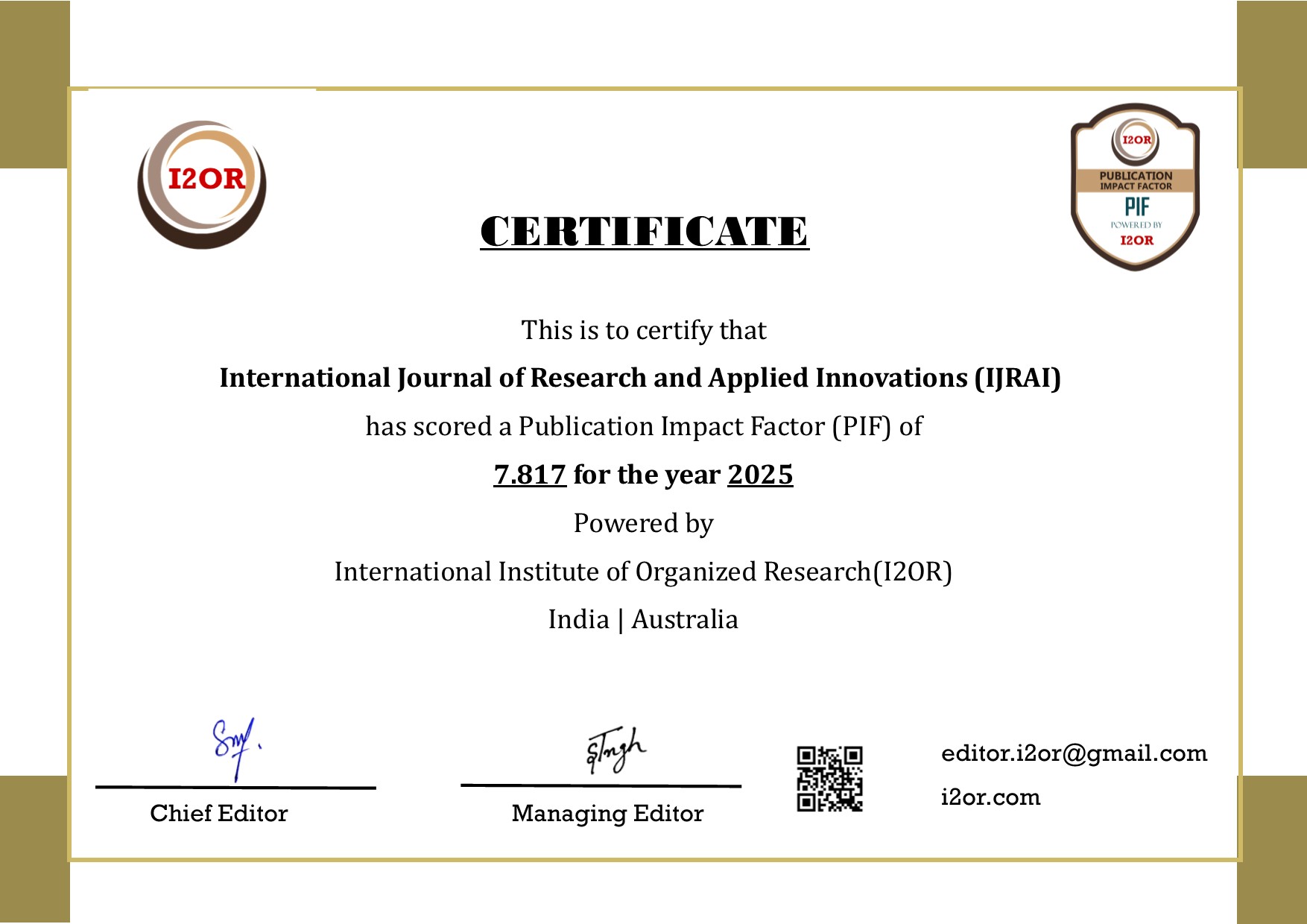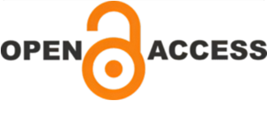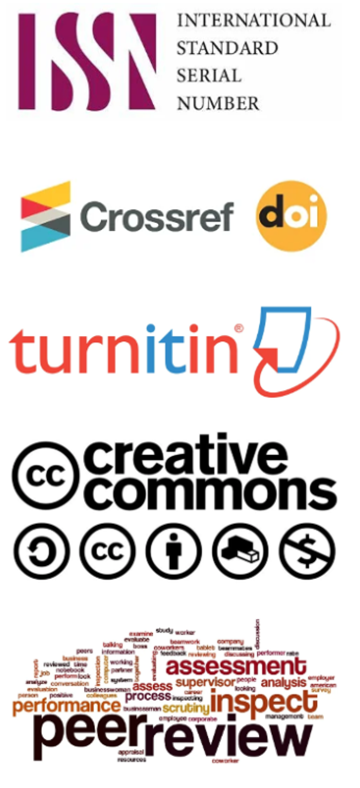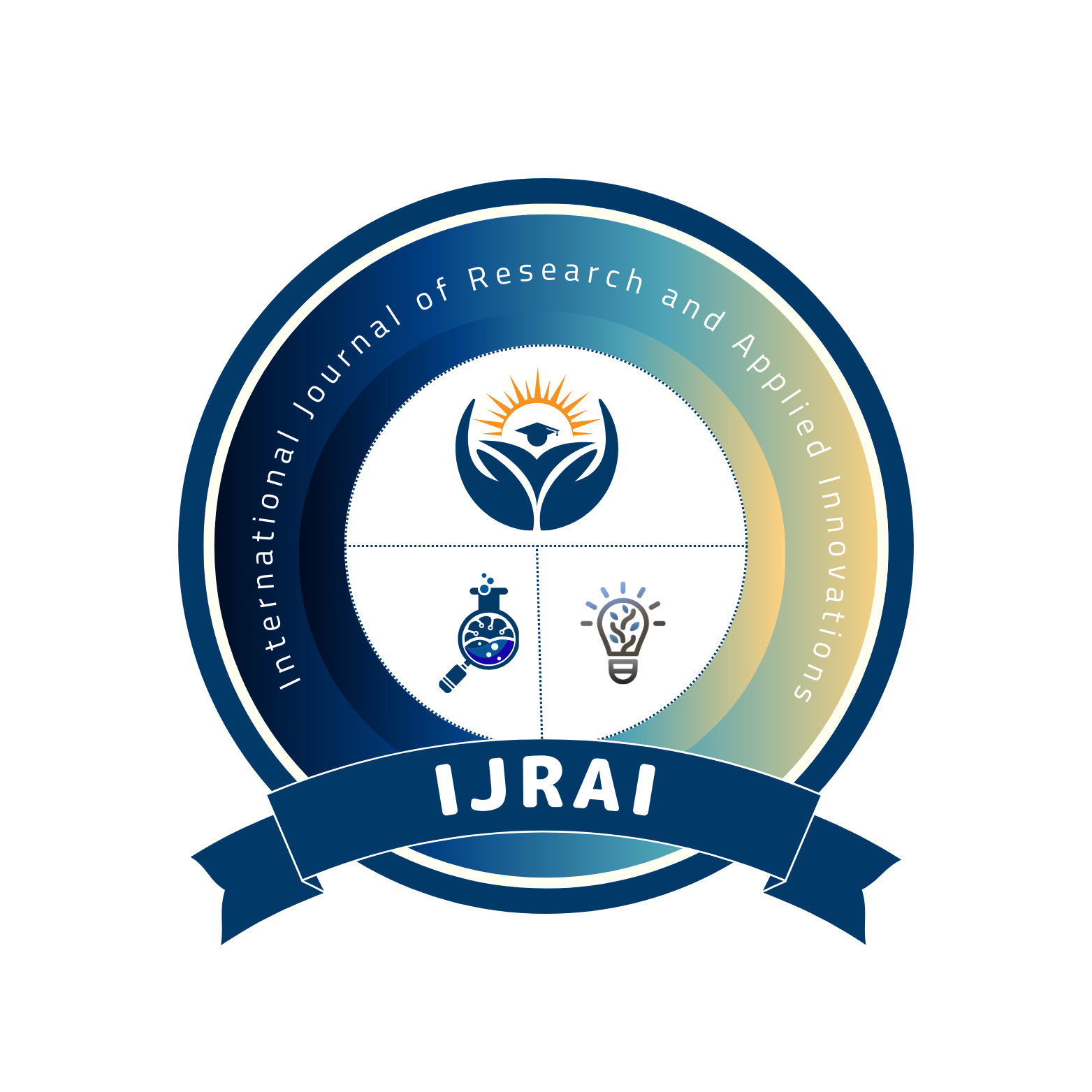Enterprise Security Architectures for Zero Trust
DOI:
https://doi.org/10.15662/IJRAI.2021.0406007Keywords:
Zero Trust Architecture, enterprise security, identity and access management, multi-factor authentication, micro-segmentation, continuous monitoring, policy-based access control, insider threats, cyber resilience, hybrid IT environmentsAbstract
Zero Trust Architecture is the new paradigm of enterprise security. This challenges the perimeter-based defense strategy. The older models, where trust was vested in the user or the device within the network boundary, are failing in an era where cloud computing is rapidly being adopted and remote work environments and mobile devices are gaining ground. Zero Trust works on the philosophy of "never trust, always verify," whereby every access request must be continually authenticated, authorized, and validated by dynamic policies before access is allowed to any resource. Such a methodology uses a series of critical technologies and procedures, like MFA, IAM, micro-segmentation, and continuous monitoring of user activity and device integrity. The goal is to reduce an attack surface, decrease the chances of lateral movement in networks, and increase visibility across all endpoints. Zero Trust Architecture (ZTA) does not just counter cyber threats from the outside but also mitigates insider threats, thereby ensuring compromised account credentials and devices will not allow insiders to gain unauthorized access to critical systems. For enterprises, embracing Zero Trust comes as a phased process, taking the form of policy formulation, technological upgrades, and cultural adaptation. While difficult, it includes higher complexity levels and initial expenses, but more significant long-term benefits are more significant in fighting modern cyber threats. Zero Trust helps organizations form a stronger security posture that delivers data protection amidst the increasingly decentralized and hybrid environment of IT systems. This paper explores the key components, benefits, and strategies for implementing ZTA and underscores its critical role in future-proof enterprise security frameworks.
References
1. Patchamatla, P. S. (2020). Comparison of virtualization models in OpenStack. International Journal of Multidisciplinary Research in Science, Engineering and Technology, 3(03).
2. Patchamatla, P. S., & Owolabi, I. O. (2020). Integrating serverless computing and kubernetes in OpenStack for dynamic AI workflow optimization. International Journal of Multidisciplinary Research in Science, Engineering and Technology, 1, 12.
3. Patchamatla, P. S. S. (2019). Comparison of Docker Containers and Virtual Machines in Cloud Environments. Available at SSRN 5180111.
4. Patchamatla, P. S. S. (2021). Implementing Scalable CI/CD Pipelines for Machine Learning on Kubernetes. International Journal of Multidisciplinary and Scientific Emerging Research, 9(03), 10-15662.
5. Thepa, P. C., & Luc, L. C. (2017). The role of Buddhist temple towards the society. International Journal of Multidisciplinary Educational Research, 6(12[3]), 70–77.
6. Thepa, P. C. A. (2019). Niravana: the world is not born of cause. International Journal of Research, 6(2), 600-606.
7. Thepa, P. C. (2019). Buddhism in Thailand: Role of Wat toward society in the period of Sukhothai till early Ratanakosin 1238–1910 A.D. International Journal of Research and Analytical Reviews, 6(2), 876–887.
8. Acharshubho, T. P., Sairarod, S., & Thich Nguyen, T. (2019). Early Buddhism and Buddhist archaeological sites in Andhra South India. Research Review International Journal of Multidisciplinary, 4(12), 107–111.
9. Phanthanaphruet, N., Dhammateero, V. P. J., & Phramaha Chakrapol, T. (2019). The role of Buddhist monastery toward Thai society in an inscription of the great King Ramkhamhaeng. The Journal of Sirindhornparithat, 21(2), 409–422.
10. Bhujell, K., Khemraj, S., Chi, H. K., Lin, W. T., Wu, W., & Thepa, P. C. A. (2020). Trust in the sharing economy: An improvement in terms of customer intention. Indian Journal of Economics and Business, 20(1), 713–730.
11. Khemraj, S., Thepa, P. C. A., & Chi, H. (2021). Phenomenology in education research: Leadership ideological. Webology, 18(5).
12. Sharma, K., Acharashubho, T. P. C., Hsinkuang, C., ... (2021). Prediction of world happiness scenario effective in the period of COVID-19 pandemic, by artificial neuron network (ANN), support vector machine (SVM), and regression tree (RT). Natural Volatiles & Essential Oils, 8(4), 13944–13959.
13. Thepa, P. C. (2021). Indispensability perspective of enlightenment factors. Journal of Dhamma for Life, 27(4), 26–36.
14. Acharashubho, T. P. C. (n.d.). The transmission of Indian Buddhist cultures and arts towards Funan periods on 1st–6th century: The evidence in Vietnam. International Journal of Development Administration Research, 4(1), 7–16.
15. Vadisetty, R., Polamarasetti, A., Guntupalli, R., Rongali, S. K., Raghunath, V., Jyothi, V. K., & Kudithipudi, K. (2021). Legal and Ethical Considerations for Hosting GenAI on the Cloud. International Journal of AI, BigData, Computational and Management Studies, 2(2), 28-34.
16. Vadisetty, R., Polamarasetti, A., Guntupalli, R., Raghunath, V., Jyothi, V. K., & Kudithipudi, K. (2021). Privacy-Preserving Gen AI in Multi-Tenant Cloud Environments. Sateesh kumar and Raghunath, Vedaprada and Jyothi, Vinaya Kumar and Kudithipudi, Karthik, Privacy-Preserving Gen AI in Multi-Tenant Cloud Environments (January 20, 2021).
17. Vadisetty, R., Polamarasetti, A., Guntupalli, R., Rongali, S. K., Raghunath, V., Jyothi, V. K., & Kudithipudi, K. (2020). Generative AI for Cloud Infrastructure Automation. International Journal of Artificial Intelligence, Data Science, and Machine Learning, 1(3), 15-20.
18. Sowjanya, A., Swaroop, K. S., Kumar, S., & Jain, A. (2021, December). Neural Network-based Soil Detection and Classification. In 2021 10th International Conference on System Modeling & Advancement in Research Trends (SMART) (pp. 150-154). IEEE.
19. Harshitha, A. G., Kumar, S., & Jain, A. (2021, December). A Review on Organic Cotton: Various Challenges, Issues and Application for Smart Agriculture. In 2021 10th International Conference on System Modeling & Advancement in Research Trends (SMART) (pp. 143-149). IEEE.
20. Jain, V., Saxena, A. K., Senthil, A., Jain, A., & Jain, A. (2021, December). Cyber-bullying detection in social media platform using machine learning. In 2021 10th International Conference on System Modeling & Advancement in Research Trends (SMART) (pp. 401-405). IEEE.
21. Gandhi Vaibhav, C., & Pandya, N. Feature Level Text Categorization For Opinion Mining. International Journal of Engineering Research & Technology (IJERT) Vol, 2, 2278-0181.
22. Gandhi Vaibhav, C., & Pandya, N. Feature Level Text Categorization For Opinion Mining. International Journal of Engineering Research & Technology (IJERT) Vol, 2, 2278-0181.
23. Gandhi, V. C. (2012). Review on Comparison between Text Classification Algorithms/Vaibhav C. Gandhi, Jignesh A. Prajapati. International Journal of Emerging Trends & Technology in Computer Science (IJETTCS), 1(3).
24. Desai, H. M., & Gandhi, V. (2014). A survey: background subtraction techniques. International Journal of Scientific & Engineering Research, 5(12), 1365.
25. Maisuriya, C. S., & Gandhi, V. (2015). An Integrated Approach to Forecast the Future Requests of User by Weblog Mining. International Journal of Computer Applications, 121(5).
26. Maisuriya, C. S., & Gandhi, V. (2015). An Integrated Approach to Forecast the Future Requests of User by Weblog Mining. International Journal of Computer Applications, 121(5).
27. esai, H. M., Gandhi, V., & Desai, M. (2015). Real-time Moving Object Detection using SURF. IOSR Journal of Computer Engineering (IOSR-JCE), 2278-0661.
28. Gandhi Vaibhav, C., & Pandya, N. Feature Level Text Categorization For Opinion Mining. International Journal of Engineering Research & Technology (IJERT) Vol, 2, 2278-0181.
29. Singh, A. K., Gandhi, V. C., Subramanyam, M. M., Kumar, S., Aggarwal, S., & Tiwari, S. (2021, April). A Vigorous Chaotic Function Based Image Authentication Structure. In Journal of Physics: Conference Series (Vol. 1854, No. 1, p. 012039). IOP Publishing.
30. Jain, A., Sharma, P. C., Vishwakarma, S. K., Gupta, N. K., & Gandhi, V. C. (2021). Metaheuristic Techniques for Automated Cryptanalysis of Classical Transposition Cipher: A Review. Smart Systems: Innovations in Computing: Proceedings of SSIC 2021, 467-478.
31. Gandhi, V. C., & Gandhi, P. P. (2022, April). A survey-insights of ML and DL in health domain. In 2022 International Conference on Sustainable Computing and Data Communication Systems (ICSCDS) (pp. 239-246). IEEE.
32. Dhinakaran, M., Priya, P. K., Alanya-Beltran, J., Gandhi, V., Jaiswal, S., & Singh, D. P. (2022, December). An Innovative Internet of Things (IoT) Computing-Based Health Monitoring System with the Aid of Machine Learning Approach. In 2022 5th International Conference on Contemporary Computing and Informatics (IC3I) (pp. 292-297). IEEE.
33. Dhinakaran, M., Priya, P. K., Alanya-Beltran, J., Gandhi, V., Jaiswal, S., & Singh, D. P. (2022, December). An Innovative Internet of Things (IoT) Computing-Based Health Monitoring System with the Aid of Machine Learning Approach. In 2022 5th International Conference on Contemporary Computing and Informatics (IC3I) (pp. 292-297). IEEE.
34. Sharma, S., Sanyal, S. K., Sushmita, K., Chauhan, M., Sharma, A., Anirudhan, G., ... & Kateriya, S. (2021). Modulation of phototropin signalosome with artificial illumination holds great potential in the development of climate-smart crops. Current Genomics, 22(3), 181-213.
35. Agrawal, N., Jain, A., & Agarwal, A. (2019). Simulation of network on chip for 3D router architecture. International Journal of Recent Technology and Engineering, 8(1C2), 58-62.
36. Jain, A., AlokGahlot, A. K., & RakeshDwivedi, S. K. S. (2017). Design and FPGA Performance Analysis of 2D and 3D Router in Mesh NoC. Int. J. Control Theory Appl. IJCTA ISSN, 0974-5572.
37. Arulkumaran, R., Mahimkar, S., Shekhar, S., Jain, A., & Jain, A. (2021). Analyzing information asymmetry in financial markets using machine learning. International Journal of Progressive Research in Engineering Management and Science, 1(2), 53-67.
38. Subramanian, G., Mohan, P., Goel, O., Arulkumaran, R., Jain, A., & Kumar, L. (2020). Implementing Data Quality and Metadata Management for Large Enterprises. International Journal of Research and Analytical Reviews (IJRAR), 7(3), 775.
39. Kumar, S., Prasad, K. M. V. V., Srilekha, A., Suman, T., Rao, B. P., & Krishna, J. N. V. (2020, October). Leaf disease detection and classification based on machine learning. In 2020 International Conference on Smart Technologies in Computing, Electrical and Electronics (ICSTCEE) (pp. 361-365). IEEE.
40. Karthik, S., Kumar, S., Prasad, K. M., Mysurareddy, K., & Seshu, B. D. (2020, November). Automated home-based physiotherapy. In 2020 International Conference on Decision Aid Sciences and Application (DASA) (pp. 854-859). IEEE.
41. Rani, S., Lakhwani, K., & Kumar, S. (2020, December). Three dimensional wireframe model of medical and complex images using cellular logic array processing techniques. In International conference on soft computing and pattern recognition (pp. 196-207). Cham: Springer International Publishing.
42. Raja, R., Kumar, S., Rani, S., & Laxmi, K. R. (2020). Lung segmentation and nodule detection in 3D medical images using convolution neural network. In Artificial Intelligence and Machine Learning in 2D/3D Medical Image Processing (pp. 179-188). CRC Press.
43. Kantipudi, M. P., Kumar, S., & Kumar Jha, A. (2021). Scene text recognition based on bidirectional LSTM and deep neural network. Computational Intelligence and Neuroscience, 2021(1), 2676780.
44. Rani, S., Gowroju, S., & Kumar, S. (2021, December). IRIS based recognition and spoofing attacks: A review. In 2021 10th International Conference on System Modeling & Advancement in Research Trends (SMART) (pp. 2-6). IEEE.
45. Kumar, S., Rajan, E. G., & Rani, S. (2021). Enhancement of satellite and underwater image utilizing luminance model by color correction method. Cognitive Behavior and Human Computer Interaction Based on Machine Learning Algorithm, 361-379.
46. Rani, S., Ghai, D., & Kumar, S. (2021). Construction and reconstruction of 3D facial and wireframe model using syntactic pattern recognition. Cognitive Behavior and Human Computer Interaction Based on Machine Learning Algorithm, 137-156.
47. Rani, S., Ghai, D., & Kumar, S. (2021). Construction and reconstruction of 3D facial and wireframe model using syntactic pattern recognition. Cognitive Behavior and Human Computer Interaction Based on Machine Learning Algorithm, 137-156.
48. Kumar, S., Raja, R., Tiwari, S., & Rani, S. (Eds.). (2021). Cognitive behavior and human computer interaction based on machine learning algorithms. John Wiley & Sons.
49. Shitharth, S., Prasad, K. M., Sangeetha, K., Kshirsagar, P. R., Babu, T. S., & Alhelou, H. H. (2021). An enriched RPCO-BCNN mechanisms for attack detection and classification in SCADA systems. IEEE Access, 9, 156297-156312.
50. Kantipudi, M. P., Rani, S., & Kumar, S. (2021, November). IoT based solar monitoring system for smart city: an investigational study. In 4th Smart Cities Symposium (SCS 2021) (Vol. 2021, pp. 25-30). IET.
51. Sravya, K., Himaja, M., Prapti, K., & Prasad, K. M. (2020, September). Renewable energy sources for smart city applications: A review. In IET Conference Proceedings CP777 (Vol. 2020, No. 6, pp. 684-688). Stevenage, UK: The Institution of Engineering and Technology.
52. Raj, B. P., Durga Prasad, M. S. C., & Prasad, K. M. (2020, September). Smart transportation system in the context of IoT based smart city. In IET Conference Proceedings CP777 (Vol. 2020, No. 6, pp. 326-330). Stevenage, UK: The Institution of Engineering and Technology.
53. Meera, A. J., Kantipudi, M. P., & Aluvalu, R. (2019, December). Intrusion detection system for the IoT: A comprehensive review. In International Conference on Soft Computing and Pattern Recognition (pp. 235-243). Cham: Springer International Publishing.
54. Garlapati Nagababu, H. J., Patel, R., Joshi, P., Kantipudi, M. P., & Kachhwaha, S. S. (2019, May). Estimation of uncertainty in offshore wind energy production using Monte-Carlo approach. In ICTEA: International Conference on Thermal Engineering (Vol. 1, No. 1).









